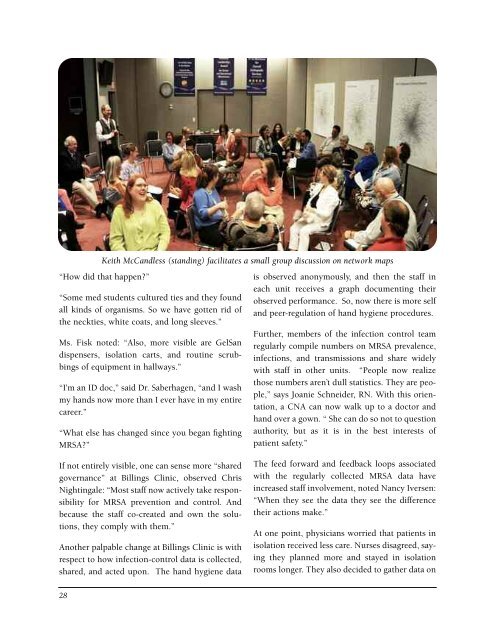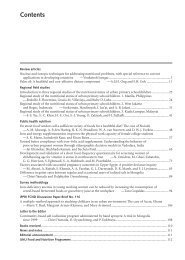From Invisible to Visible - Positive Deviance Initiative
From Invisible to Visible - Positive Deviance Initiative
From Invisible to Visible - Positive Deviance Initiative
Create successful ePaper yourself
Turn your PDF publications into a flip-book with our unique Google optimized e-Paper software.
Keith McCandless (standing) facilitates a small group discussion on network maps<br />
“How did that happen?”<br />
“Some med students cultured ties and they found<br />
all kinds of organisms. So we have gotten rid of<br />
the neckties, white coats, and long sleeves.”<br />
Ms. Fisk noted: “Also, more visible are GelSan<br />
dispensers, isolation carts, and routine scrubbings<br />
of equipment in hallways.”<br />
“I’m an ID doc,” said Dr. Saberhagen, “and I wash<br />
my hands now more than I ever have in my entire<br />
career.”<br />
“What else has changed since you began fighting<br />
MRSA?”<br />
is observed anonymously, and then the staff in<br />
each unit receives a graph documenting their<br />
observed performance. So, now there is more self<br />
and peer-regulation of hand hygiene procedures.<br />
Further, members of the infection control team<br />
regularly compile numbers on MRSA prevalence,<br />
infections, and transmissions and share widely<br />
with staff in other units. “People now realize<br />
those numbers aren’t dull statistics. They are people,”<br />
says Joanie Schneider, RN. With this orientation,<br />
a CNA can now walk up <strong>to</strong> a doc<strong>to</strong>r and<br />
hand over a gown. “ She can do so not <strong>to</strong> question<br />
authority, but as it is in the best interests of<br />
patient safety.”<br />
If not entirely visible, one can sense more “shared<br />
governance” at Billings Clinic, observed Chris<br />
Nightingale: “Most staff now actively take responsibility<br />
for MRSA prevention and control. And<br />
because the staff co-created and own the solutions,<br />
they comply with them.”<br />
Another palpable change at Billings Clinic is with<br />
respect <strong>to</strong> how infection-control data is collected,<br />
shared, and acted upon. The hand hygiene data<br />
The feed forward and feedback loops associated<br />
with the regularly collected MRSA data have<br />
increased staff involvement, noted Nancy Iversen:<br />
“When they see the data they see the difference<br />
their actions make.”<br />
At one point, physicians worried that patients in<br />
isolation received less care. Nurses disagreed, saying<br />
they planned more and stayed in isolation<br />
rooms longer. They also decided <strong>to</strong> gather data on<br />
28

















